Журнальный клуб Интелрос » Joint Force Quarterly » №77, 2015
Two of joint doctrine’s keystone1 joint publications (JPs) have entered the window for revision—JP 3-0, Joint Operations, and JP 5-0, Joint Operation Planning. Both publications received comprehensive assessments in 2014, which generated a wide variety of recommended changes from combatant commands (CCMD), the Services, National Guard Bureau, Defense agencies, and the Joint Staff. This article describes the more significant of these.

KC-135 Stratotanker assigned to 465th Air Refueling Squadron, 507th Air Refueling Wing, delivers fuel to F/A-18F Super Hornet assigned to Black Knights of Strike Fighter Squadron 154 supporting Rim of the Pacific 2010 exercises (U.S. Air Force/Kamaile O. Long)
JP 3-0 (August 11, 2011) is the latest in a series of keystone JPs to address joint operations. JP 3-0 began as a January 1990 “test publication” titled Doctrine for Unified and Joint Operations.2 General Colin Powell, then Chairman of the Joint Chiefs of Staff (CJCS), approved the first official version of JP 3-0 in 1993. It codified agreements that had been reached among the Joint Chiefs on a number of contentious aspects of joint operations.3 In 1995, General John Shalikashvili, General Powell’s successor,4 issued JP 3-0 with the Joint Doctrine Professional Library Desk Set,5 which was made available on the Internet to increase access to and understanding of joint doctrine. Since then, the joint doctrine development community has revised JP 3-0 in 2001, 2006, and 2011. There also was a Change 1 in 2008 to ensure continuity with JP 1, and a Change 2 in 2010 to incorporate text on cyberspace and cyberspace operations.
What’s Next? As a keystone publication, JP 3-0 has a symbiotic relationship with other publications in the joint doctrine hierarchy. JP 3-0 establishes (and is the authoritative source for) fundamental constructs with which other JPs must be consistent. Examples include the 12 principles of joint operations (appendix A of JP 3-0) and six joint functions (chapter III), as well as definitions for the terms joint force, commander’s intent, and operational art. Similarly, other topic-focused JPs, such as JP 3-60, Joint Targeting, establish authoritative models and terms that influence the content of JP 3-0 and others. It is a challenge for JP authors to limit redundancy while sharing relevant material across joint publications. The joint community should see this challenge play out during the next year or so as authors of JPs 3-0, 5-0, and 3-20 (Security Cooperation) collaborate to achieve a balanced treatment of security cooperation, a topic sourced to JP 3-20 that affects both keystone JPs and others. The joint community can expect to see the following notable changes in the first draft of JP 3-0.
Security cooperation continuity across JP 3-0, JP 5-0, and JP 3-20 on the topic of security cooperation (SC) is one of the important issues that emerged during the JP 3-0 assessment and in events such as the semi-annual Joint Doctrine Planning Conference. JP 3-22, Foreign Internal Defense, is the current authoritative source for joint doctrine on SC, but JP 3-20 will assume this role when approved in late 2015. Joint Doctrine Planning Conference voting members approved development of a security cooperation JP to address the lack of understanding of SC, its relevance, and its relationship to activities such as security force assistance and foreign internal defense.
JP 3-0 currently covers security cooperation6 primarily in context of low-range military operations, which focus on military engagement, security cooperation, and deterrence.7Both JP 3-0 and JP 5-0 describe SC as it relates to the notional phases of a joint operation.8 Responses to the JP 3-0 assessment, supported by findings in the Decade of War, Volume I study9 and various exercise observations, are sufficient to conclude that a more comprehensive discussion of SC is necessary. A new JP 3-20 should provide this discussion, and perhaps a revised definition. Consistent with JP 3-20, JP 3-0 will clarify the role of security cooperation with respect to the range of military operations, and JP 5-0 will cover SC in the context of theater campaign planning.
Security cooperation and a related topic, stability operations,10 overlap in the general context of promoting a stable environment in a combatant commander’s (CCDR’s) area of responsibility (AOR). However, JP 3-0 does not address SC in sufficient detail with respect to its relationship to stability operations.11 In a broad context, both SC and stability operations consist of activities that help maintain or improve stability consistent with U.S. objectives. Security cooperation, occasionally referenced informally as Phase Zero activities, is a central component of the CCDR’s theater campaign plan. Security cooperation activities occur constantly within a CCDR’s broader AOR, even if circumstances during more intense operations preclude these activities in a designated joint operations area. Stability operations, such as emergency infrastructure reconstruction, can occur in Phase Zero (“Shape”), but are not SC activities. While the magnitude of stability operations in a joint operations area will increase and decrease through the phases in many operations, security cooperation activities should remain relatively constant elsewhere in the AOR.12 In addition to JPs 3-0, 3-20, and 5-0, JP 3-07, Stability Operations, is part of the solution to achieve clear and balanced doctrinal coverage of the security cooperation and stability operations relationship.
Assessment. In the context of gauging a military force’s effectiveness during operations, the 2001 JP 3-0 focused on combat assessment. This is a tactical-level assessment of battle damage and munitions effectiveness that generates re-attack recommendations and supports targeting decisions. JP 3-0 retained combat assessment in 2006, and expanded the assessment discussion to the operational level through emphasis on creating desired effects and use of measures of effectiveness (MOEs) and measures of performance (MOPs). The 2006 JP 5-0 contained a closely related assessment discussion based on JP 3-0, and with slightly more detail. In 2011, the balance of doctrine on assessment shifted significantly from JP 3-0 to JP 5-0 (as described later in this article).
Joint force feedback generated a number of comments on the term assessment and the topic’s treatment in joint doctrine. In particular, U.S. Central Command requested an extensive expansion of joint doctrine’s assessment coverage. Assessment is a continuous process that measures the overall effectiveness of employing joint force capabilities during military operations by determining progress toward accomplishing tasks, creating conditions, and achieving objectives.13 The main theme of feedback comments is that JP 3-0 should provide more detail on assessment and clarify a misunderstanding across CCMDs regarding who is responsible for developing an assessment plan during joint operation planning. Moreover, some commenters believe the discussion on developing MOEs and MOPs does not adequately address the challenge of developing an assessment plan that will help guide decisions and identify opportunities and risks during execution. Although the comments have merit, JP 3-0 is only part of the solution. JP 3-0 will provide a revised definition and an overview of assessment, while JP 5-0 will be the authoritative source for most of the keystone-level assessment doctrine.
Concepts. Approved concepts provide important potential sources of new ideas that can improve joint doctrine. In 2011, JP 3-0 incorporated common operating precepts from the January 15, 2009, Capstone Concept for Joint Operations (CCJO).14 The 10 precepts underlie successful joint operations and supplement the 12 principles of joint operations. The precepts flow logically from the broad challenges in the strategic environment to the specific conditions, circumstances, and influences in a joint force commander’s operational environment.15
The Chairman of the Joint Chiefs of Staff approved the latest Capstone Concept for Joint Operations: Joint Force 2020 in 2012.16 It proposes an approach called globally integrated operations, which focuses on globally postured joint force elements that can combine quickly with each other and inter-organizational partners to integrate capabilities fluidly across domains, echelons, geographic boundaries, and organizational affiliations. Essential to realizing the CCJO’s globally integrated operations is the projection of power despite antiaccess and area-denial challenges.17
The Joint Operational Access Concept (JOAC)18 focuses on the ability to overcome these challenges and project military force into an operational area with sufficient freedom of action to accomplish the mission. Implementing the JOAC currently is a comprehensive, multiyear effort managed by the Joint Staff Joint Force Development Directorate (J7) in conjunction with other Joint Staff directorates, CCMDs, Services, and Defense agencies. The joint doctrine contribution to the effort involves potential changes between now and 2020 to at least 35 JPs that span all joint functions. The current JP 3-0 mentions the importance of access to operational areas, but readers should expect to see an expansion of this discussion during the upcoming revision, beginning with emphasis on SC activities that can set the peacetime conditions for gaining and maintaining operational access as the JOAC envisions.
Content Reorganization. In addition to changes highlighted above, content organization adjustments will be evident in the JP 3-0 first draft. These focus on redistributing major topics in the current chapter V, “Joint Operations across the Range of Military Operations,” to provide a more logical sequence and improve readability of the 65-page chapter. A new chapter V, “Joint Operations across the Conflict Continuum,” will discuss the range of military operations; types of military operations; the phasing construct (current figure V-3 and related text); the balance of offense, defense, and stability operations (current figure V-4 and related text); and linear and nonlinear operations. The reorganization will shift the remainder of the current chapter V information into three chapters: chapter VI, “Military Engagement, Security Cooperation, and Deterrence”; chapter VII, “Crisis Response and Limited Contingency Operations”; and chapter VIII, “Major Operations and Campaigns.” The new chapter V will group related topics and position them to provide a better introduction to the three subsequent chapters.
Conclusion. The JP 3-0 revision will be informed by the latest information available from joint community feedback, various lessons learned and best practices from current operations, and relevant, validated constructs identified during assessment of approved joint concepts. The revision will also focus on achieving continuity and appropriate balance of related topics like security cooperation in publications such as JP 3-20 and JP 5-0. The objective is to ensure that, when approved in 2016, the revised keystone joint operations publication remains a relevant and current doctrinal foundation for all other JPs.

Army paratroopers wait to perform personnel airdrop mission during joint operational access exercise, Fort Bragg, June 2011 (U.S. Air Force/Asha Harris)
The Joint Doctrine Professional Library Desk Set also included the 1995 JP 5-0, Doctrine for Planning Joint Operations. This version was substantially different in form from the current JP 5-0, and more strategically focused. When published, the 1995 JP 5-0 was the keystone planning publication in a series that included seven additional planning JPs.19 However, four of these were Joint Operation Planning and Execution System (JOPES) JPs that the Joint Staff J5 was updating and republishing as CJCS instructions. A fifth provided information on JOPES automated data processing support.
Two other JPs in the 1995 joint planning series supported JP 5-0. JP 5-00.1, Joint Tactics, Techniques, and Procedures for Joint Campaign Planning, was revised in 2002 asJoint Doctrine for Campaign Planning, and was then merged into the December 26, 2006, revision of JP 5-0. JP 5-00.2, Joint Task Force Planning Guidance and Procedures, was revised in 1999. During the 2007 revision, it was renumbered and renamed JP 3-33, Joint Task Force Headquarters, leaving JP 5-0 as the only remaining planning-focused joint publication.
What’s Next? The 2014 formal assessment and analysis indicated that the current JP 5-0 discussion of operational-level planning is largely sufficient. The joint community should not expect to see significant changes in chapter II, “Strategic Direction and Joint Operation Planning”; chapter III, “Operational Art and Operational Design”; and chapter IV, “Joint Operation Planning Process.” However, the analysis also concluded that, while the primary operational-level focus (planning for contingencies) of the current publication is sound, major gaps exist in doctrine for theater- and national-strategic planning. Additionally, discontinuity remains between contingency plans, theater strategic planning, and the strategic decisionmaking process at the Department of Defense (DOD) level. The current JP 5-0 does not address development of a CCDR’s theater campaign plan and the nesting of contingency plans and relevant country plans, nor does it address the role of planning in support of national decisions. The joint community can expect to see the following notable changes in the first draft of JP 5-0.
Scope. First, the title of JP 5-0 will change from “Joint Operation Planning” to “Joint Planning” to reflect the expanded scope of the publication. Chapter I, “Role of Joint Planning,” will be expanded to address the different requirements placed on planning at the national decisionmaking level (national approach) and the requirements of the joint force to execute operations when directed by the President or Secretary of Defense. This chapter will also introduce the campaign as the tool that DOD uses to translate national strategic guidance into ongoing activities to achieve national objectives. This will include a discussion of using “threat sets” in planning. Briefly, threat sets consider the whole of a military problem, particularly the interrelated planning tasks of multiple CCMDs that cross the gaps and seams between geographic and functional commands and link interrelated threats to response options in the context of continuous risk assessment under the direction of a supported commander. Threat sets define the priority effort of a complex contingency problem and help define the supporting and supported command relationships across CCMDs.
The most significant change is the addition of a new chapter titled “Campaign Planning.” This chapter will assist CCMD planners in developing their command’s campaign and using it to link theater operations to national strategy and CCMD campaign plans to subordinate contingency plans. The chapter will emphasize campaign assessments to address concerns about how assessments are conducted, their purpose in measuring success of the campaign, and the link between campaigns and resourcing.

Tandem jumpers from Army Golden Knights Parachute Team free fall after jumping from Air Force Special Operations Command CV-22 Osprey over MacDill Air Force Base (DOD)
Role of Joint Planning. Added to chapter I, “Role of Joint Planning,” is a discussion on the differing perspectives of planning between the CCMDs and national-level decisionmakers. Planners face the challenge of developing specific plans to address identified threat sets, while a national approach to the issues has not been fully decided. The result is that national-level decisionmakers want to consider a wide range of options (across the diplomatic, informational, military, and economic instruments of national power, with associated risk assessments), and are often cautious about committing to a specific approach and providing specific guidance too quickly before a crisis occurs. Conversely, joint force planners require specific guidance (and decisions on assumptions such as timing, expected force levels, and coalition support) to conduct in-depth analysis to provide the requisite level of assessment to inform the decision process. This tension allows senior decisionmakers to preserve flexibility while getting detailed information on a wide range of possible options. In contrast, joint planners at and below the CCMD develop specific (and often narrow) military solution sets to determine requirements and risk. The revision of JP 5-0 will identify processes to help bridge this gap and satisfy the information needs of both sides.
Second, national-level guidance is often broad and unconstrained. The processes identified in JP 5-0 will help CCDRs and their staffs develop strategy and plan campaigns to bridge the gap between national policy and joint operation planning. The description of the theater campaign plan as the top-level CCMD plan links national strategy to daily activities, which are directed in the CCDR’s campaign plans and provide a foundation for developing contingency plans.
Campaign Planning and the Purpose of the Campaign. The update to JP 5-0 will include a new chapter titled “Strategy and Campaign Development” in addition to the existing chapter on operational planning. This chapter will link CCMD campaign plans to the CCMD strategy and its operation and contingency plans. The CCMD campaigns serve as the DOD translation of national strategic guidance into actionable and operational-level activities within the resources available. The CCDR assesses the environment and the command’s ability to influence change within the guidance, authorities, and available resources. This enables senior leader strategic discussions linking realistic and achievable objectives and associated risks to national objectives across a wide range of options. This chapter will introduce several new concepts:
A significant change to the proposed campaign planning construct is that campaign and contingency planning will occur within the restrictions of existing resources. This “resource-informed” planning, as directed in the 2015 Guidance for the Employment of the Force and 2015 Joint Strategic Capabilities Plan, requires the planner to assess the objectives of the campaign, the likelihood of contingencies, and balance the forces, posture, fiscal resources, materiel, and authorities that are available and have been apportioned to prepare a successful plan. DOD policy directs that plans not serve as CCDR demand signals.
Assessment. The current discussion on assessment expands to address assessments that support campaign planning. The primary topics of discussion at the strategic level center on the CCDR’s assessment of the environment, the operation, and risk associated with the campaign and any operation.
The current JP 5-0 addresses assessments as an element of the plan (assessments are included in the plan to evaluate the effectiveness of that plan in achieving its objectives). The expanded section will integrate additional details from Joint Doctrine Note 1-14, “Operation Assessment,” with a focus on how assessments aid the decisionmaking process and are used to monitor execution and adjust the campaign (and contingency plans) to improve success. Since campaigns are ongoing, assessments must be continuous and should support the development of the subsequent campaign plan. Assessments help to determine the effectiveness and efficiency of the programs in progress and those programmed in the current fiscal, force management, and training cycles. As planning occurs, ongoing assessments provide feedback and information resulting from changes in the environment (due to previously scheduled activities or ongoing operations) that may require changes in the plans currently in execution or those intended for future implementation. Continuous assessment of the campaign informs contingency planning because the assessment might validate contingency plan assumptions as well as identify changes in the environment under which a contingency is executed.
CCDRs include the assessment plan and results of ongoing assessments in the review process with national leadership. This information provides the CCDR talking points to identify national-level decisions or issues that senior leaders must address to achieve strategic objectives. Assessments identify assumptions, risks, decision points, support required from interagency and multinational partners, and other factors that either validate current progress or necessitate changes to campaign and contingency plans and ongoing operations.
Risk. The current version of JP 5-0 identifies risk as a topic of discussion and critical to the decisionmaking process, but does not provide support to help the planner identify, categorize, and discuss risk. The revised JP 5-0 will contain a new appendix on risk, helping planners identify and manage risk throughout the planning process. Improved risk discussions will improve national-level discussions and decisionmaking. Risk discussion will center on risk to the force (for example, “Do I have the correct force, ready enough?” “Are my casualty estimates acceptable?”), risk to mission (“What are the impacts if I get fewer forces, delayed timing”), risk to other missions (“What must I divert from other missions and how will that affect my ability to accomplish them?”), and the impact of political risk (“How will operations affect public opinion, local opinion, allied opinion, and adversaries?”).

U.S. Army AH-64D Apache helicopter takes off from Afloat Forward Staging Base (Interim) USS Ponce during exercise, November 2012 (U.S. Navy/Jon Rasmussen)
Content Reorganization. In addition to the major changes noted above, several other changes are proposed for the update. The in-progress review discussion and figure I-1, “Adaptive Planning Review and Approval Process,” will move to chapter V, “Joint Planning Process,” in line with its logical sequence in the process. The discussion on inter-organizational and multinational planning, previously split into two different areas in chapter II, will consolidate into one section. As mentioned, chapter III will be a new one that covers strategy and campaign development. Current chapters III and IV become chapters IV and V in the update, with similar structures as the current chapters. Two new chapters are added at the end: chapter VI covers transition to execution, to better tie in to JP 3-0, and chapter VII addresses assessments. In the appendices, the “Plan Format” appendix will be removed to reduce the size and avoid conflicts with the formats published in the CJCSM 3130 series manuals, which are updated more frequently. The appendices on flexible deterrent options and flexible response options will be combined. Two new appendices will address risk identification and management and theater posture plans.
Conclusion. Campaigns translate national-level policy and guidance into theater-strategic and operational-level activities conducted to further U.S. interests to prevent, prepare for, or mitigate the impact of a crisis or contingency. The new JP 5-0 will provide a doctrinal basis for planners at the CCMDs, Joint Staff, Service component commands, and Services to address planning for those operations and activities that DOD conducts on a continuing basis.
The 2015 JP 5-0 update enables planners to better prepare their leadership for discussions in the strategic decision space at the national and theater levels. Campaign plans operationalize national-level guidance into daily activities that shape and influence the strategic environment to prevent, prepare for, or mitigate the effects of contingencies. The 2016 JP 5-0 will address this perspective of CCMD campaigns and campaign plans. JFQ